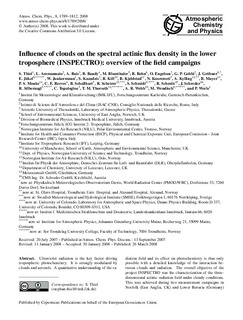Influence of clouds on the spectral actinic flux density in the lower troposphere (INSPECTRO): overview of the field campaigns
Thiel, S; Ammannato, L; Bais, A; Bandy, B; Blumthaler, M; Bohn, B; Engelsen, O; Gobbi, GP; Grobner, J; Jakel, E; Junkermann, W; Kazadzis, S; Kift, R; Kjeldstad, Berit Johanne; Kouremeti, N; Kylling, A; Mayer, B; Monks, PS; Reeves, CE; Schallhart, B; Scheirer, R; Schmidt, S; Schmitt, R; Schreder, J; Silbernagl, R; Topaloglou, C; Thorseth, Trond Morten; Webb, Ann; Wendisch, M; Werle, Peter
Journal article, Peer reviewed
Permanent lenke
http://hdl.handle.net/11250/2360395Utgivelsesdato
2008Metadata
Vis full innførselSamlinger
- Institutt for fysikk [2677]
- Publikasjoner fra CRIStin - NTNU [37703]
Sammendrag
Ultraviolet radiation is the key factor driving tropospheric photochemistry. It is strongly modulated by clouds and aerosols. A quantitative understanding of the radiation field and its effect on photochemistry is thus only possible with a detailed knowledge of the interaction between clouds and radiation. The overall objective of the project INSPECTRO was the characterization of the three-dimensional actinic radiation field under cloudy conditions. This was achieved during two measurement campaigns in Norfolk (East Anglia, UK) and Lower Bavaria (Germany) combining space-based, aircraft and ground-based measurements as well as simulations with the one-dimensional radiation transfer model UVSPEC and the three-dimensional radiation transfer model MYSTIC.
During both campaigns the spectral actinic flux density was measured at several locations at ground level and in the air by up to four different aircraft. This allows the comparison of measured and simulated actinic radiation profiles. In addition satellite data were used to complete the information of the three dimensional input data set for the simulation. A three-dimensional simulation of actinic flux density data under cloudy sky conditions requires a realistic simulation of the cloud field to be used as an input for the 3-D radiation transfer model calculations. Two different approaches were applied, to derive high- and low-resolution data sets, with a grid resolution of about 100 m and 1 km, respectively.
The results of the measured and simulated radiation profiles as well as the results of the ground based measurements are presented in terms of photolysis rate profiles for ozone and nitrogen dioxide. During both campaigns all spectroradiometer systems agreed within ±10% if mandatory corrections e.g. stray light correction were applied. Stability changes of the systems were below 5% over the 4 week campaign periods and negligible over a few days. The J(O1D) data of the single monochromator systems can be evaluated for zenith angles less than 70°, which was satisfied by nearly all airborne measurements during both campaigns. The comparison of the airborne measurements with corresponding simulations is presented for the total, downward and upward flux during selected clear sky periods of both campaigns. The compliance between the measured (from three aircraft) and simulated downward and total flux profiles lies in the range of ±15%.
